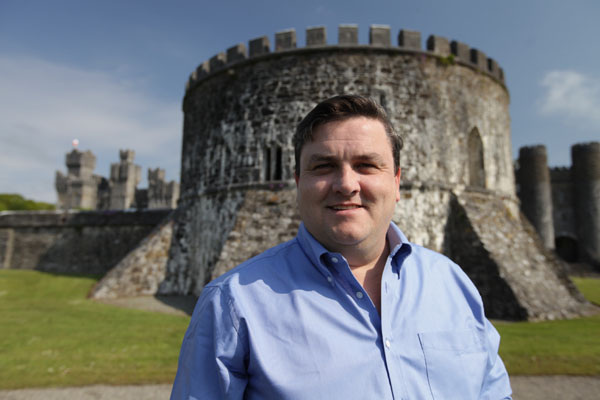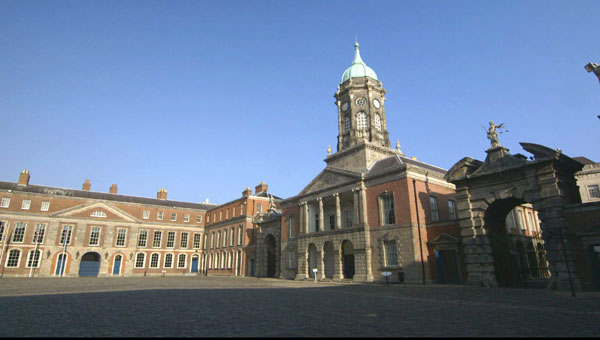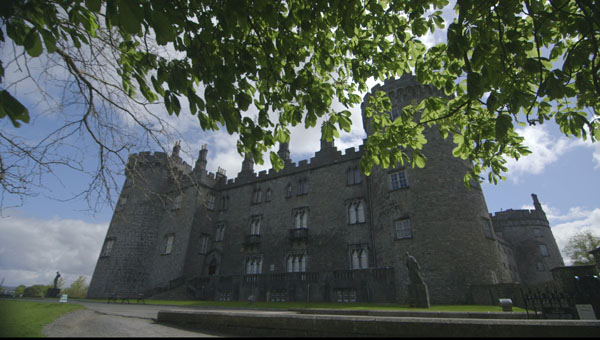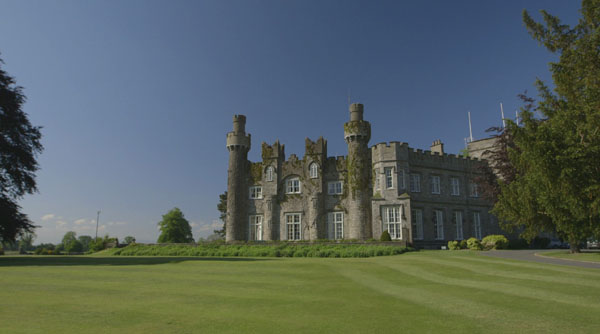“[T]he history of Irish castles is the history of Ireland itself.” And with Tales of Irish Castles, viewers get a fascinating lesson about the country as told through its castles.

Irish actor Simon Delaney (The Fall, Moone Boy, The Good Wife) is my kind of host. As he notes in the opener of Tales of Irish Castles, “History is not really my thing.” Not that it doesn’t interest him (or me). It’s just that history lessons, at least in the classroom, can tend to be a bit, well, dry.
Not so with this documentary. Tales of Irish Castles is utterly engrossing. And Delaney is, by turns, serious and humorous.
The six episodes center on several periods in Ireland’s history and cover the various stories behind more than a dozen “monuments to domination and power,” thus giving viewers a better sense of what was happening throughout the country across the centuries.
Incorporating re-enactments, archival and stunning aerial footage, and interviews with historians, archaeologists, castle owners, and current castle inhabitants, the stories — “about sieges, bloody battles, lavish lifestyles, ghostly presences, warring families, and feudal lords” — are simply riveting.
“The Normans Are Coming”
Irish castles played a key role in shaping the country’s history, starting in the 12th century. After Dermot MacMurrough’s kingdom was taken from him, he sought help from English King Henry II and got it by making a deal with Richard Fitzgilbert de Clare, 2nd Earl of Pembroke in Wales, better known by his nickname Strongbow. This led to the invasion of Ireland in 1169 by the Anglo-Normans, descendants of the French from Normandy and “the most technologically-advanced army of the time.”
Before the invasion, most of the Irish lived in ring forts alongside the Scandinavians, who had conquered Ireland 300 years earlier and controlled the trading ports in Limerick, Wexford, Waterford, and the walled city of Dublin, “a thriving Viking town.” Once Dublin was taken by the Anglo-Normans, the castle-building in Ireland began.

As the invasion continued across Ireland, the Normans built fortifications that dotted the Irish landscape, including Trim Castle in County Meath; Carrickfergus in County Antrim, Northern Ireland; Limerick Castle, aka King John’s Castle, in Limerick; and Ashford Castle in County Mayo, now a 5-star hotel.
(Click on any of the thumbnails to open the photo gallery.)
[Best_Wordpress_Gallery id=”1″ gal_title=”Tales of Irish Castles 1″]
—
“Don’t Mess with a Knight”
The building of Norman castles in Ireland continued throughout the 13th and 14th centuries, and the expansion began soon after the initial invasion of Ireland. London-based King Henry II was constantly concerned about his rule over the country across the Irish Sea, so he built a network of castles that he could control through his knights.
These “ultimate fighting machines” began training while barely out of toddler-hood. As adults they conquered and took over local Irish lords’ lands in the name of the English crown, and built huge, more complex castles to control what was now their lands. One such knight was William Marshal, described as “the greatest knight that ever lived.” He married Isabel de Clare, Strongbow’s daughter, and they built Kilkenny Castle.

While the Anglo-Normans laid siege across Ireland, the leaders of Irish clans would marry their daughters into the new ruling families to gain more clout, including the Anglo-Norman Luttrell family. They built the Luttrellstown Castle outside of Dublin, where Posh and Becks, aka Victoria and David Beckham, were married in one of the castle’s ruins in 1999.

“The Fightback”
After a few hundred years of having their lands (and themselves) overrun and run by the Anglo-Normans, Irish clans began resisting and fighting back in earnest during the 15th and 16th centuries. It was during this period that a new type of castle came into being: the tower house, built as both a defensive structure and a home. Here Simon Delaney details the haunted Leap Castle in County Offaly; Maynooth Castle in County Kildare, the first castle to be besieged by cannon fire; and the love story of Dunluce and Clonony Castle, the former in County Antrim and the latter, the resting place of Anne Boleyn’s sisters Mary and Elizabeth, in County Offaly.
“A Century of Turmoil”
The 17th century was the bloodiest century in Irish history, owing to the Confederate and Cromwellian wars during the 1640s-50s and the Williamite wars in the 1680s-90s. Here again, Irish castles played key roles, including some of the most affected and important strongholds during these periods, such as the strategic military castles in Limerick, Birr, Kilkenny, and Athlone.
[Best_Wordpress_Gallery id=”2″ gal_title=”Tales of Irish Castles 2″]
—
“A Taste for Gothic”
As castle rents have fallen and lands have been sold off, the owners of Ireland’s Gothic castles have struggled to maintain their estates. Featured in this penultimate episode are Dublin Castle; the magical Tullynally Castle in County Westmeath; Birr Castle in County Offaly, home to one of the largest telescopes in the world; and the august Charleville Castle in County Offaly, which is undergoing continuous rebuilding with the help of international volunteers.
“End of Empire”
In this final episode of Tales of Irish Castles, Simon Delaney recounts the famine and social strife of Ireland in the 19th and 20th centuries, which left many an iconic Irish castle in ruins. He then sums everything up by presenting a profile of the country’s castles, delving into the personal, military, social, and family stories behind the buildings while placing them in context historically and providing information on the state of the country, local wars, and the families who once lived in them.
Tales of Irish Castles begins premiering Thursday, 1 October 2015, on the public TV stations listed below. Check your local listings or contact the station that serves your area for broadcast dates and times. If you’d like to watch the series but your station isn’t listed, contact them or American Public Television to request it.
__________________
Add your comments on our Facebook, Google+, and Twitter pages.
Share this post/page.





